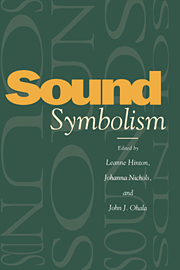Book contents
- Frontmatter
- Contents
- List of contributors
- 1 Introduction: Sound-symbolic processes
- PART I Native American languages north of Mexico
- PART II Native languages of Latin America
- PART III Asia
- PART IV Australia and Africa
- PART V Europe
- 14 Regular sound development, phonosymbolic orchestration, disambiguation of homonyms
- 15 Modern Greek ts: beyond sound symbolism
- 16 On levels of analysis of sound symbolism in poetry, with an application to Russian poetry
- 17 Finnish and Gilyak sound symbolism – the interplay between system and history
- PART VI English
- PART VII The biological bases of sound symbolism
- Index
17 - Finnish and Gilyak sound symbolism – the interplay between system and history
Published online by Cambridge University Press: 04 August 2010
- Frontmatter
- Contents
- List of contributors
- 1 Introduction: Sound-symbolic processes
- PART I Native American languages north of Mexico
- PART II Native languages of Latin America
- PART III Asia
- PART IV Australia and Africa
- PART V Europe
- 14 Regular sound development, phonosymbolic orchestration, disambiguation of homonyms
- 15 Modern Greek ts: beyond sound symbolism
- 16 On levels of analysis of sound symbolism in poetry, with an application to Russian poetry
- 17 Finnish and Gilyak sound symbolism – the interplay between system and history
- PART VI English
- PART VII The biological bases of sound symbolism
- Index
Summary
Introduction
Some of the citizens in a community of vowels are more equal than others. Thus, of the eight vowels in Finnish, ö is the least equal; y (a high rounded front vowel, like German ü) is better integrated into the lexical and inflectional-derivational system than ö, but still not as well as its back counterpart, u. This hierarchy among the Finnish vowels can be best observed in Finnish sound symbolism. What is more, it can also be observed in the history of the Finnish vowel system, in that the most recent arrival in this system is ö. This ö is also the vowel with the highest sound-symbolic index. As in the Finnish vowels, the Finnish consonants are also unequally rooted in the system, but less obviously so. Some Finnish consonants can nevertheless play a role in sound symbolism. All of these facts suggest that the idea that there is a language-specific correlation between recentness and exploitability in sound symbolism.
The main axis in the Finnish vowel system is horizontal (o:ö, u:y). The main axis in the Gilyak vowel system is vertical: e:i, o:u, a:y (where y is a high back unrounded vowel). These pairs of vowels (low vs. high) are exploited in the grammar and in the lexicon, but unequally: a:y is exploited in grammar; e:i is predictable and productive (vowel harmony); o:u is unsystematic, irregular, and highly affective. (The historical dimension – lexical ablaut as it issues from reconstruction – is ignored here.)
- Type
- Chapter
- Information
- Sound Symbolism , pp. 249 - 260Publisher: Cambridge University PressPrint publication year: 1995



